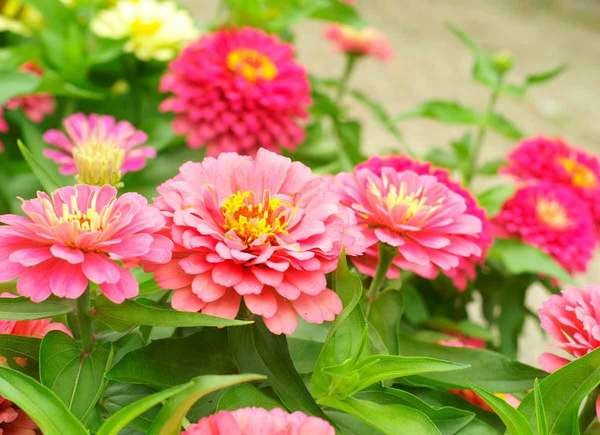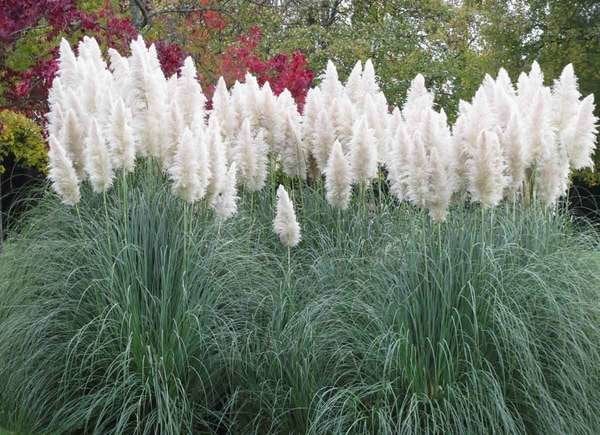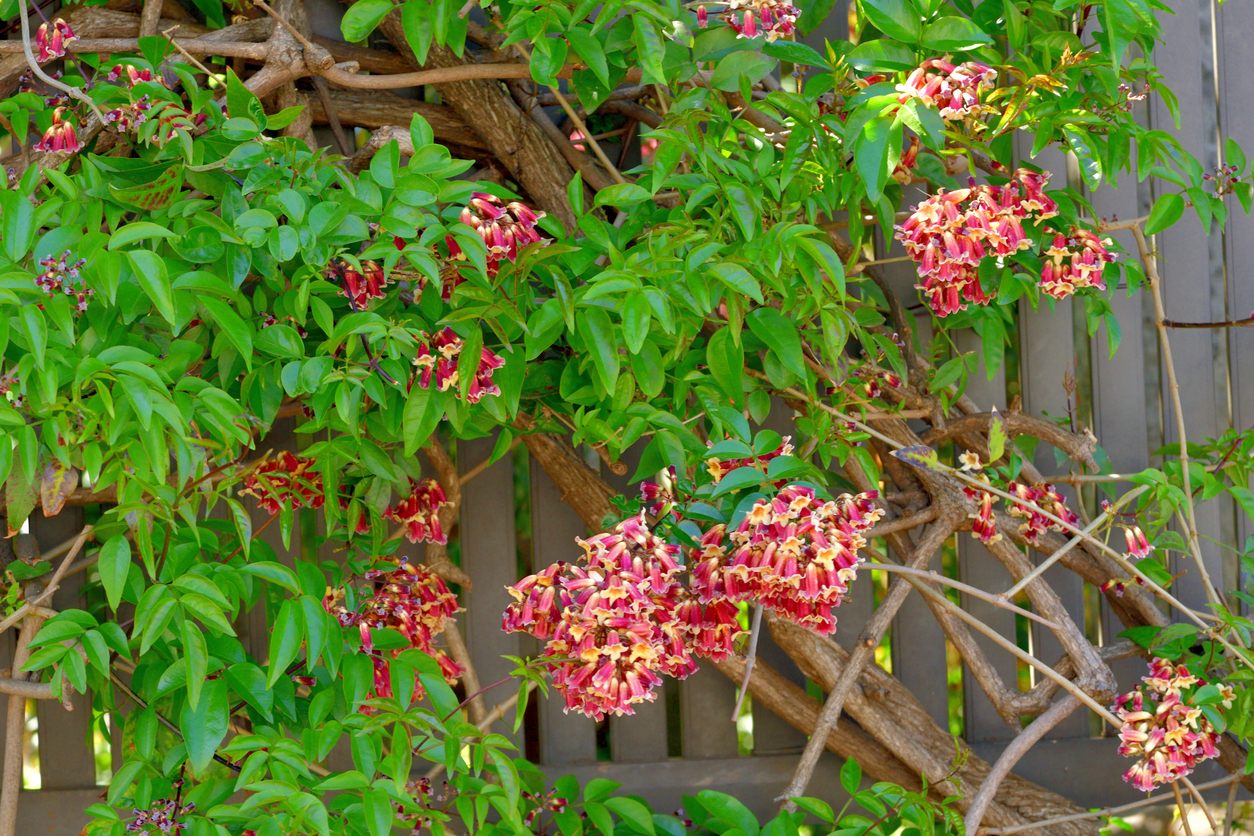

We may earn revenue from the products available on this page and participate in affiliate programs. Learn More ›
Extreme weather was in the news again recently when the average worldwide temperature hit new highs, day after day. In early July, the heat index reached nearly 110 degrees Fahrenheit from Texas to Florida, and broke some records in Southwest deserts. As global warming tightens its grip on the planet, gardeners who are determined to grow a beautiful landscape would be wise to make note of drought- and heat-tolerant plants that have evolved to withstand brutal temperatures.
Our recommendations for plants that grow in 100-degree weather offer the possibility of a landscape complete with bedding plants, specimen plants, ground covers, vines, and trees. They prove that it’s indeed possible to live in extreme heat and still have a beautiful garden.
1. Butterfly Weed (Asclepias tuberosa)

This bright and showy perennial attracts butterflies and honeybees with large yellow-orange heads that stand strong when other plants droop from the heat. Butterfly weed grows well in Zones 3 through 9 of the USDA’s Plant Hardiness Map, and it reaches 2 to 3 feet at maturity. The multi-blossom heads show from June through late August, making it a seasonal favorite for borders and flower beds.
RELATED: 17 Drought-Tolerant Plants That Can Survive Dry Spells
2. Purple Coneflower (Echinacea purpurea)

You’ll find purple coneflower growing wild along country roads throughout the Midwest in zones 3 through 8. The heat-tolerant beauty blooms in the sizzling summer temperatures of June through August. While the native version tends to look a little gangly near the end of its bloom cycle, hybridized cultivars (such as Powwow Wild Berry) maintain a more compact height of 2 to 3 feet, making them well suited to the home garden.
RELATED: 20 Flowers That Attract Bees to Your Garden
3. Lantana (Lantana camara)

A standout in Southern and Southwestern gardens, lantana begins blooming in July and doesn’t stop until the first autumn frost. In hardiness zones 10 and 11, lantana is a perennial shrub that blooms year after year, producing eye-catching blossoms in a range of colors like soft yellow, pink, bright orange, and vivid red. In zones 7 through 9, gardeners can grow lantana as an annual. This small shrub reaches a diminutive 12 inches high, and it resists both drought and heat.
RELATED: 20 Perennials to Plant in the Fall for Beautiful Spring Flowers
4. Egyptian Star Cluster (Pentas lanceolata)

Although it’s a perennial in zones 10 and 11, Egyptian star cluster is widely grown as an annual in zones 3 through 9. The plant can reach 3 feet high, and it blooms from early summer until the first frost. Its red or pink star-shaped flowers attract butterflies and hummingbirds even on the hottest summer day.
RELATED: 10 Foolproof Flowers Anyone Can Grow
5. Viburnum (Viburnum dentatum)

In May and June, viburnum offers homeowners a showy display of soft white, faintly fragrant clusters of blossoms. During the remaining summer months, the plant transforms into a glossy green specimen shrub, standing up to hot temperatures and hosting birds and small wildlife beneath its sweeping boughs. Viburnum reaches an average height of 8 to 10 feet, with the hybrid cultivar Siebold topping out at 20 feet. The plant is suitable for hardiness zones 2 through 8.
RELATED: 20 Pretty Plants That Will Make Your Garden Smell Great
6. Zinnia (Zinnia elegans)

Producing a rainbow of bright colors—such as purple, pink, fire-engine red, and soft cream—common zinnias are a heat-tolerant favorite in zones 2 through 11. These prolific annuals come in a variety of heights ranging from one to five feet. The large flowers (sometimes 5 inches wide!) grow from sturdy stems that withstand strong winds and high temperatures. They’re perfect for your flower bed!
RELATED: How to Grow Zinnias
7. Yucca (Yucca elephantipes)

Native to hot and dry regions of America, the yucca grows as a perennial in zones 5 through 10, though it thrives best in hotter zones. Its needle-sharp leaves create a prickly mound, followed in late spring by one or more flower-covered spikes. These shoot up from the center of the plant and bear dozens of soft cream blossoms. When other plants begin to wilt in the heat, yucca (which is considered a broadleaf evergreen) stands tall and strong, a striking showpiece in your rock garden or xeriscaped yard.
RELATED: The 8 Best Places To Buy Plants Online
8. Blanket Flower (Gaillardia grandiflora)

Also known as blanket flower—most likely because a grouping of gaillardia (Gaillardia × grandiflora) resembles the natural colors and patterns inherent in traditional Native American blankets—gaillardia thrives in hot, dry temperatures. The heat-lover blooms nonstop from June through September, and it grows 1 to 3 feet tall. What’s more, gaillardia bears daisy-like blooms in a range of colors, from soft oranges and yellows to dusty reds and maroon shades. Gaillardia is a perennial in zones 3 through 9.
RELATED: 30 Low-Maintenance Plants for Your Easiest Garden Ever
9. Celosia (Celosia argentea)

A perennial in zones 10 through 11, celosia is grown as an annual elsewhere in the United States. This favorite bedding plant boasts brightly colored feathery plumes in orange, purple, yellow, red, and white. These blossoms rise as much as 1 to 3 feet above a base of green foliage, and they bloom from summer through fall. Celosia remains upright and strong even in sizzling heat, making it a favorite of flower gardeners across America.
RELATED: 25 Easy-Care Plants That Survive With or Without You
10. Pampas Grass (Cortaderia selloana)

One of the most popular ornamental grasses, pampas grass sends feathery ivory plumes up to 10 feet high, making it a top choice for natural borders and backdrops. In addition to tolerating high temperatures, pampas grass also resists drought and wind once it’s established. Native to Brazil and Argentina, it’s grown as a perennial in zones 7 through 11, and it can be planted in large pots in zones 4 through 6 if overwintered in a greenhouse.
RELATED: The 22 Best Ornamental Grasses for Adding Drama to Your Property
11. Firecracker Penstemon (Penstemon eatonii)

Flourishing in the desert conditions of the southwestern United States, firecracker penstemon is grown as a perennial in zones 4 through 9. Brilliant red flowers adorn tall stalks that rise two to three feet above a leafy base. This cheerful plant starts blooming in early spring and continues through midsummer. Once established, firecracker penstemon needs very little care. It will bloom year after year while tolerating heat, drought, and windy conditions.
RELATED: 12 Gardening Mistakes That Are Killing Your Plants
12. Shasta Daisy (Leucanthemum × superbum)

Home gardeners have been growing this perennial favorite for decades. Prized for its pure white blooms with brilliant yellow eyes, the Shasta daisy plant displays a visually striking contrast between its dark green foliage and its prolific blooms, which stay strong on slender stems, even in scorching temperatures. This time-honored plant is hardy in zones 5 through 9, but keep in mind that it doesn’t care for wet soil. The Shasta daisy is an especially great choice for containers and perennial borders.
RELATED: 12 Best Flowers for Starting from Seed
13. Portulaca (Portulaca grandiflora)

Also known as moss rose, portulaca is an annual, so it must be replanted every year. Even so, it thrives in most regions of the country—specifically in hardiness zones 2 through 11 (and can be a tender perennial in zones 10 to 12). Common purslane (P. oleracea) is its weedy relative that is grown as an edible plant in some areas. Regardless, both types have brilliant blossoms and succulent leaves that survive the dog days of summer. While purslane reaches only 6 to 8 inches high, it can spread 18 to 20 inches, making it perfect as a ground cover or addition to a hanging basket.
RELATED: These Popular Plants Might Actually Be Bad for Your Garden
14. Cosmos (Cosmos bipinnatus)

Easily grown from seeds, cosmos is a heat-loving annual that flourishes in hardiness zones 2 through 11. In June, delicate daisy-like blooms in shades of white, pink, and purple appear on willowy stems that can reach heights of 5 feet. Blooming continues unabated until the first frost, even during the hottest summer months. Most gardeners grow cosmos in borders or containers. Let this year’s seeds drop on the ground, and you’ll have another crop of cosmos next year.
RELATED: 20 Plants That Thrive Even When Temperatures Rise
15. Rock rose (Pavonia lasiopetala)

Chief among the heat tolerant flowers for Texas is rock rose, a native of the Lone Star State that displays pretty pink flowers all summer long. And while its roots are in Texas, pavonia does well in other hot areas, such as Arizona, as it can adapt to a wide variety of well-draining soils. This low-maintenance, loose shrub can grow to 4 feet tall and wide; its medium-green leaves are covered with tiny white “hairs” that give them a velvety appearance. This drought-tolerant plant can take a string of triple-digit days and come out smelling like a (rock) rose.
RELATED: 22 Shrubs That Can Handle the Heat of Full Sun
16. Sotol (Dasylirion wheeleri)

If you’re after a desert vibe, consider sotol, also called Desert Spoon. The serrated edges of its spiky leaves are admittedly a bit vicious, but its overall appearance is a wonderful addition to hot and dry landscapes. Dozens of upright, light green/gray blades emit from a central whorl; the blades fade at their tips to delicate, light brown bits of wisp that soften the look of the plant. Sotols are full sun, heat-tolerant plants that are suited for zones 7 through 11. When temperatures drop below 20 degrees Fahrenheit in the cooler zones, though, you may lose the tops of a few of the blades. Sotol is a slow grower that can eventually reach 5 feet tall and wide.
RELATED: 10 of the Cheapest Places to Buy Land in the U.S.
17. Autumn Sage (Salvia greggii)

Another favorite among the heat tolerant plants for Texas and other surface-of-the-sun locales is autumn sage, which as often as not goes by its scientific name. A small shrub, growing to 2 feet tall and wide, Salvia greggii sprouts columns of delicate flowers in pink, red, or white atop tall spires. It’s hardy in zones 6 to 9, remaining evergreen in the southern reaches of its realm. It’s not picky about soil, as long as it drains well, and it likes lots of sun but can tolerate a bit of afternoon shade. The plant’s small leaves emit a minty fragrance, and its flowers attract hummingbirds and pollinators.
RELATED: 20 Pretty Plants That Will Make Your Garden Smell Great
18. Oregano (Origanum vulgare)

Among the plants that grow in 100 degree weather is oregano, an evergreen, drought-tolerant herb that spreads rapidly to make a lush—and wonderful-smelling—summertime ground cover. Hardy in zones 5 through 10, oregano needs well-draining, neutral to alkaline soil. Numerous varieties have various growth habits, some staying low to the ground with a spread habit, while others grow taller with a more mounding form. If you’re looking for heat tolerant plants for containers, consider oregano, giving it a good haircut during winter to encourage new growth in the spring. A bonus, of course, when growing oregano, is the plant’s culinary applications: Fresh oregano for tonight’s pasta sauce, anyone?
RELATED: 15 Perennial Herbs to Grow for Years of Fresh Flavor, Pest Control, and Cleaning Supplies
19. Crossvine (Bignonia capreolata)

Vining plants are often a part of a landscape, and crossvine is among the drought and heat tolerant plants that can be used to adorn a fence or an arbor. Masses of 2-inch-long trumpet-shaped orange flowers emerge from the vine in early spring, providing a show-stopping display. Hardy to zone 6b, crossvine likes full sun and does well in a variety of soil types. Its leaves emerge a cheery light green in spring, darkening as summer wears on, and changing to a purple hue come autumn.
RELATED: 10 Climbing Plants That Are Easy to Keep Under Control
20. Crape myrtle (Lagerstroemia indica)

It’s hard to drive a mile in the South without seeing a crape myrtle tree along the highway or in someone’s yard. This small, sun-loving tree sports numerous large clusters of delicate, papery blooms in pink, white, red, or purple when Mother Nature turns up the heat. These specimen trees will grow in almost any kind of soil, and they are hardy to zone 6 or 7. In periods of extended drought, you may see the leaves wilting a bit, so while it can take the heat, it, like all of us, needs a drink now and then.
